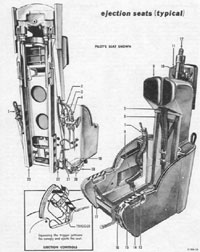

Crew stations in the B-58
Emergency EgressThere were two emergency systems utilized in the B-58, the standard open ejection seat and the Stanley encapsulated ejection seats later fitted to production B-58s (but not to TB-58As, which retained the original seats).Standard Ejection Seat The original SACseat-type open ejection seat initially installed in the B-58A and later the
TB-58A was a ballistic-initiated, rocket-catapult ejection system which operated
independently of other aircraft systems. The backrest of the seat provided storage for
a backpack type parachute and the bucket portion of the seat provided storage for
the survival kit. A gas operated human-seat separation system facilitated separating
the crewmember from the seat once clear of the aircraft.
The original SACseat-type open ejection seat initially installed in the B-58A and later the
TB-58A was a ballistic-initiated, rocket-catapult ejection system which operated
independently of other aircraft systems. The backrest of the seat provided storage for
a backpack type parachute and the bucket portion of the seat provided storage for
the survival kit. A gas operated human-seat separation system facilitated separating
the crewmember from the seat once clear of the aircraft.
Each seat was mounted on ejection rails which were attached to each aft cabin bulkhead. Slide blocks on the back of each seat engaged the ejection rails and maintained the seat in a position such that its path of travel was parallel to the rails. The seat catapult, mounted on bulkhead attached brackets behind the seat supported a seat adjustment actuator which in turn supported the seat and the canopy actuator. An initiator to blow the hatch was activated by a hand-operated trigger handle in each armrest and a second (delayed) initiator was used to activate the ejection seat rockets in the proper sequence for "safe" ejection. The pilot station had slightly angled rails to guide the seat out of the center of the hatch opening since the pilot seat was offset to the left for visibility around the center windscreen post. Stanley Encapsulated Ejection Seat
After the 1962 deaths of crewmembers in high-speed ejections, a new Stanley Aviation "escape capsule" was introduced that sealed each crewman into a clamshell capsule prior to ejection to improve his chances of survival in a supersonic ejection. The pilot capsules had a viewport and the pilot capsule even had the control stick inside the capsule so the aircraft could be flown with the capsule closed if a pressurization emergency occurred. The capsule could be reopened if desired without ejection. The navigator and DSO stations had very similar if not identical seats. The capsules would self-stabilize after ejection; had inflatable floatation devices for water landings; and contained a survival kit, including a radio, a survival rifle, and even a change of clothing! If you think about it, this last item makes more than a little sense.
B-58 rescue capsule from Marek Rys on Vimeo. More of Marek's fine work may be found on in the Gallery.
The three piece clamshell doors pivoted on each side of the seat to close. There were bars that pulled the crewmembers knees back toward his chest to ensure that the crewmember was entirely inside the capsule when it closed for obvious reasons. Emergency oxygen and pressurization were automatically actuated by capsule closure to maintain a safe atmosphere inside the capsule during freefall from maximum altitude. After the capsules were closed (in about 1/4 second), and pressurization was achieved each crew member ejected by squeezing one or both ejection trigger handles. This action fired the hatch jettison actuator and the rocket catapult initiator. If the hatch failed to jettison, the capsule would push the hatch open in the same manner as the earlier B-58 open seat system. The escape capsule was retrofitted to older B-58s, but not to TB-58s. The capsule was tested using live bears as test subjects. One of the unfortunate bears was stuffed and is now kept at the Edwards test flight museum.
The Stanley seat provided safe emergency egress under all conditions ranging from 100 knots and zero altitude up to maximum aircraft design speed and altitude. From 0 to 100 knots however, you were in God's hands...
 Peace was our Profession... Peace was our Profession...Copyright © 1994-2025 Alex P. Brewer, Jr. and Randy A. Brewer The B-58 Hustler Page B-58.com |